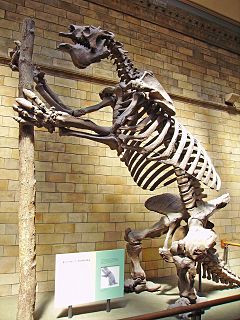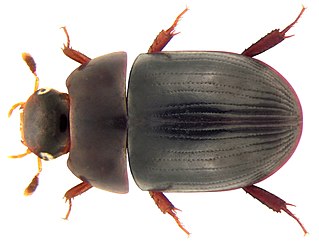
Megatherium is an extinct genus of ground sloths endemic to South America that lived from the Early Pliocene through the end of the Pleistocene. It is best known for the elephant-sized type species M. americanum, sometimes called the giant ground sloth, or the megathere, native to the Pampas through southern Bolivia during the Pleistocene. Various other smaller species belonging to the subgenus Pseudomegatherium are known from the Andes. Megatherium is part of the sloth family Megatheriidae, which also includes the similarly elephantine Eremotherium, which was native to tropical South America and southern North America. Only a few other land mammals equaled or exceeded M. americanum in size, such as large proboscideans and the giant rhinoceros Paraceratherium. Megatherium was first discovered in 1788 on the bank of the Luján River in Argentina. The holotype specimen was then shipped to Spain the following year wherein it caught the attention of the paleontologist Georges Cuvier, who was the first to determine, by means of comparative anatomy, that Megatherium was a sloth. Megatherium became extinct around 12,000 years ago during the Quaternary extinction event, which also claimed most other large mammals in the New World. The extinction coincides with the settlement of the Americas, and a kill site where a M. americanum was slaughtered and butchered is known, suggesting that hunting could have caused its extinction.

A mastodon is any proboscidean belonging to the extinct genus Mammut that inhabited North and Central America during the late Miocene or late Pliocene up to their extinction at the end of the Pleistocene 10,000 to 11,000 years ago. Mastodons lived in herds and were predominantly forest-dwelling animals that lived on a mixed diet obtained by browsing and grazing, somewhat similar to their distant relatives, modern elephants, but probably with greater emphasis on browsing.

Solanum americanum, commonly known as American black nightshade, small-flowered nightshade or glossy nightshade is a herbaceous flowering plant of wide though uncertain native range. The certain native range encompasses the tropics and subtropics of the Americas, Melanesia, New Guinea, and Australia.

Erythronium americanum, the trout lily, yellow trout lily, or yellow dogtooth violet, is a species of perennial, colony forming, spring ephemeral flower native to North America and dwelling in woodland habitats. Within its range it is a very common and widespread species, especially in eastern North America. The common name "trout lily" refers to the appearance of its gray-green leaves mottled with brown or gray, which allegedly resemble the coloring of brook trout.

Amblyomma americanum, also known as the lone star tick, the northeastern water tick, or the turkey tick, or the ‘’Cricker Tick’’, is a type of tick indigenous to much of the eastern United States and Mexico, that bites painlessly and commonly goes unnoticed, remaining attached to its host for as long as seven days until it is fully engorged with blood. It is a member of the phylum Arthropoda, class Arachnida. The adult lone star tick is sexually dimorphic, named for a silvery-white, star-shaped spot or "lone star" present near the center of the posterior portion of the adult female shield (scutum); adult males conversely have varied white streaks or spots around the margins of their shields.

Zodion is a large genus of flies from the family Conopidae.

Ribes americanum is a North American species of flowering plant in the gooseberry family known as wild black currant, American black currant, and eastern black currant. It is widespread in much of Canada and the northern United States.
Eosentomon zodion is a species of proturan in the family Eosentomidae. It is found in Europe & Northern Asia.
Siagonium americanum is a species of flat rove beetle in the family Staphylinidae. It is found in North America.

Siagonium is a genus of flat rove beetles in the family Staphylinidae. There are about 12 described species in Siagonium.

Zuphium americanum is a species of ground beetle in the family Carabidae.
Zodion intermedium is a species of thick-headed flies in the family Conopidae.
Omophron americanum, the American round sand beetle, is a species of ground beetle in the family Carabidae. It is found in, as well as native to, North America, ranging across most of the United States and Canada, except British Columbia.
Heteroplectron is a genus of caddisflies in the family Calamoceratidae. There are at least three described species in Heteroplectron.
Zodion fulvifrons is a species of thick-headed flies in the family Conopidae.
Zodion obliquefasciatum is a species of thick-headed flies in the family Conopidae.

Dactylosternum is a genus of water scavenger beetles in the family Hydrophilidae. There are more than 20 described species in Dactylosternum.

Armases is a genus of true crabs in the family Sesarmidae. There are about 13 described species in Armases.

Bembidion americanum is a species of ground beetle in the family Carabidae. It is found in North America.

Cryptopleurum is a genus of water scavenger beetles in the family Hydrophilidae. There are about 11 described species in Cryptopleurum.












